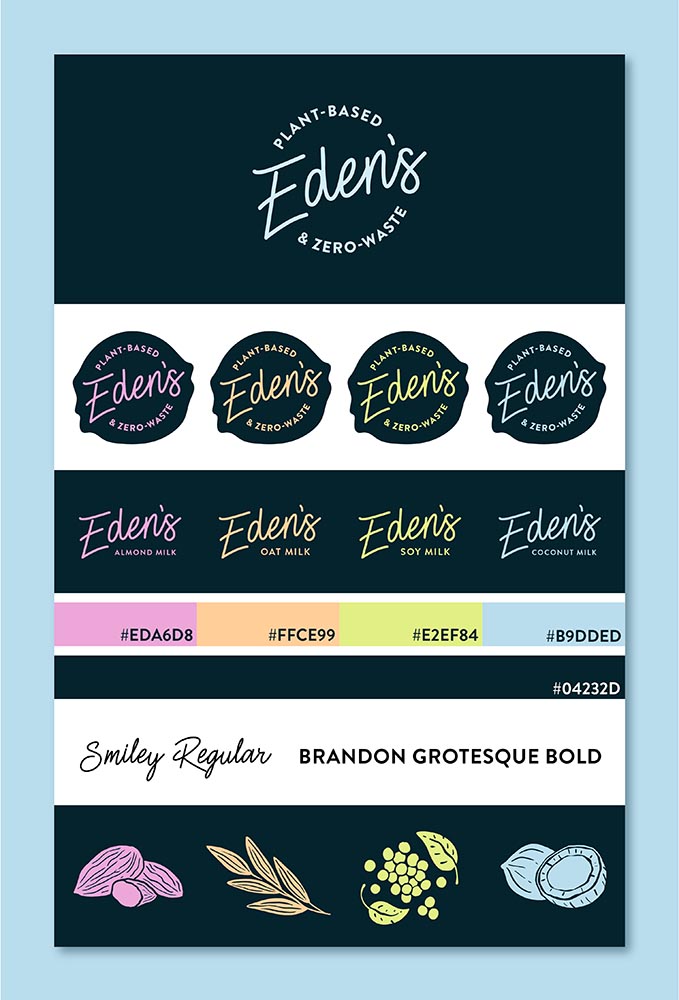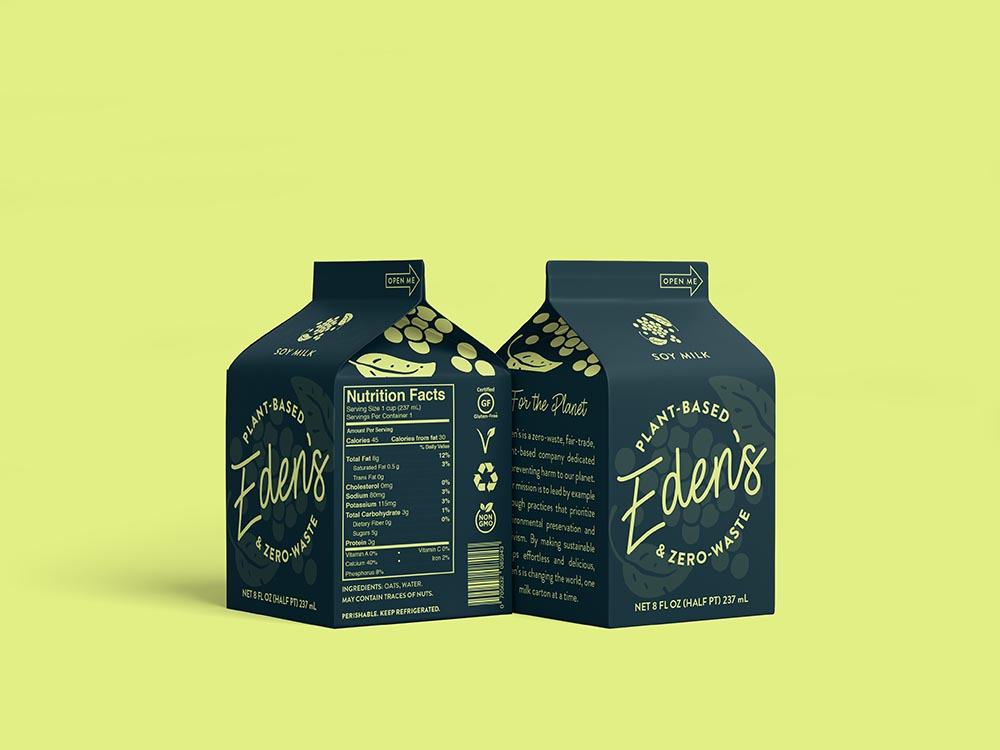Eden's: An Origin Story, Annie Wheeler
Annie Wheeler
Eden's Process Book, 2020
Digital and Print Media
8.5 x 11"
Procreate
Images courtesy of the designer
Artist statement:
This project was designed to answer two different questions: 1) how can I apply and expand my pre-existing skill set when confronted with an unfamiliar medium? and 2) when all outside influences and expectations are eliminated, who am I as a designer? From these two prompts, Eden’s was born. Eden’s is a zero-waste, plant-based milk company dedicated to a more sustainable future for our planet. Although this brand is fictional, it embodies a very real message: designers have the responsibility and the privilege to use their gifts to create positive change in the world.
The first half of this project was conducting an extensive branding process. The first crucial step was market research. Four different plant-based companies were identified as the most successful brands currently in the market: Oatly, Almond Breeze, Califia Farms, and Ripple. A competitive analysis was conducted for each of the four companies, identifying 1) what trends were distinct or consistent, 2) what design elements were most successful, and 3) how can a new company set itself apart from the rest of the competition? This market research was a fundamental step guiding the rest of the branding process.

Next was developing a distinct brand identity by creating a specific target audience and a mission statement. After researching consumers with plant-based tendencies, a profile was constructed around the following demographics: Millennials/Gen Z, women, humanitarians, vegans/vegetarians/pescatarians, progressives/liberals/leftists, the LGBTQ+ community, environmental activists, and health-conscious individuals. From there, a mission statement was developed to speak to this specific target audience: “____ is a zero-waste, fair-trade, plant-based company dedicated to preventing unnecessary harm to our planet. Our mission is to lead by examples through practices that prioritize environmental preservation and climate activism. By making sustainable swaps effortless, delicious, and rewarding, ____ is changing the world for the better, one carton at a time.” The final step before the design work could begin was choosing a brand name. Since many of my Instagram followers fell into the above demographics, I used the platform as a resource for further research. I posted three polls on my Instagram story to measure the success of four different possible names. From there, Eden’s was born.
After all of these preliminary steps were completed, it was finally time to dive into the visual branding. Two different moodboards were created to conceptualize possibilities for the look and feel of the company. The logo process was a lengthy ordeal informed by color theory and an extensive font study. I established the brandmark, primary and secondary fonts, and a rough direction for the color palette. The branding process took several weeks, and many of the brand elements were tweaked and adjusted as I moved into the product design phase.
One of the most important components of this project was prototyping the actual product. This was a brand-new medium, so I did a lot of preliminary research to gain a better understanding of best practices. Over the course of five weeks, I prototyped four different cartons with distinct flavor profiles: coconut milk, almond milk, soy milk, and oat milk. I also designed a four-carton carrier. The most difficult challenge was maintaining a consistent brand identity while still representing four separate, distinctive products. The final product deliverables are a coconut milk 4-pack, an almond milk 4-pack, a soy milk 4-pack, an oat milk 4-pack, and a variety pack with all four flavors. Each of these products has its own customized carrier to distinguish between the different options.
All of the above steps were completed during the first semester of the 2020-2021 school year; the second semester was more focused on developing and refining marketing strategies to actually sell the product. The final deliverables include a pitch deck and a digital branding guide. Additionally, a process book was designed and printed to display every step of this project, from initial concept development and market research to the final products.
Ultimately, this project was successful in answering both of my preliminary questions. I tackled the foreign medium of product design by applying all of my previous design training and learned many new techniques along the way. I also discovered more about who I am as a designer when no one else is looking. I learned that branding is one of my biggest passions that I hope to continue in my future career. I also realized that having passion for a cause elevates my creativity to a whole new level. Overall, I can proudly say that this exhibition is the culmination of my best work as a designer.







